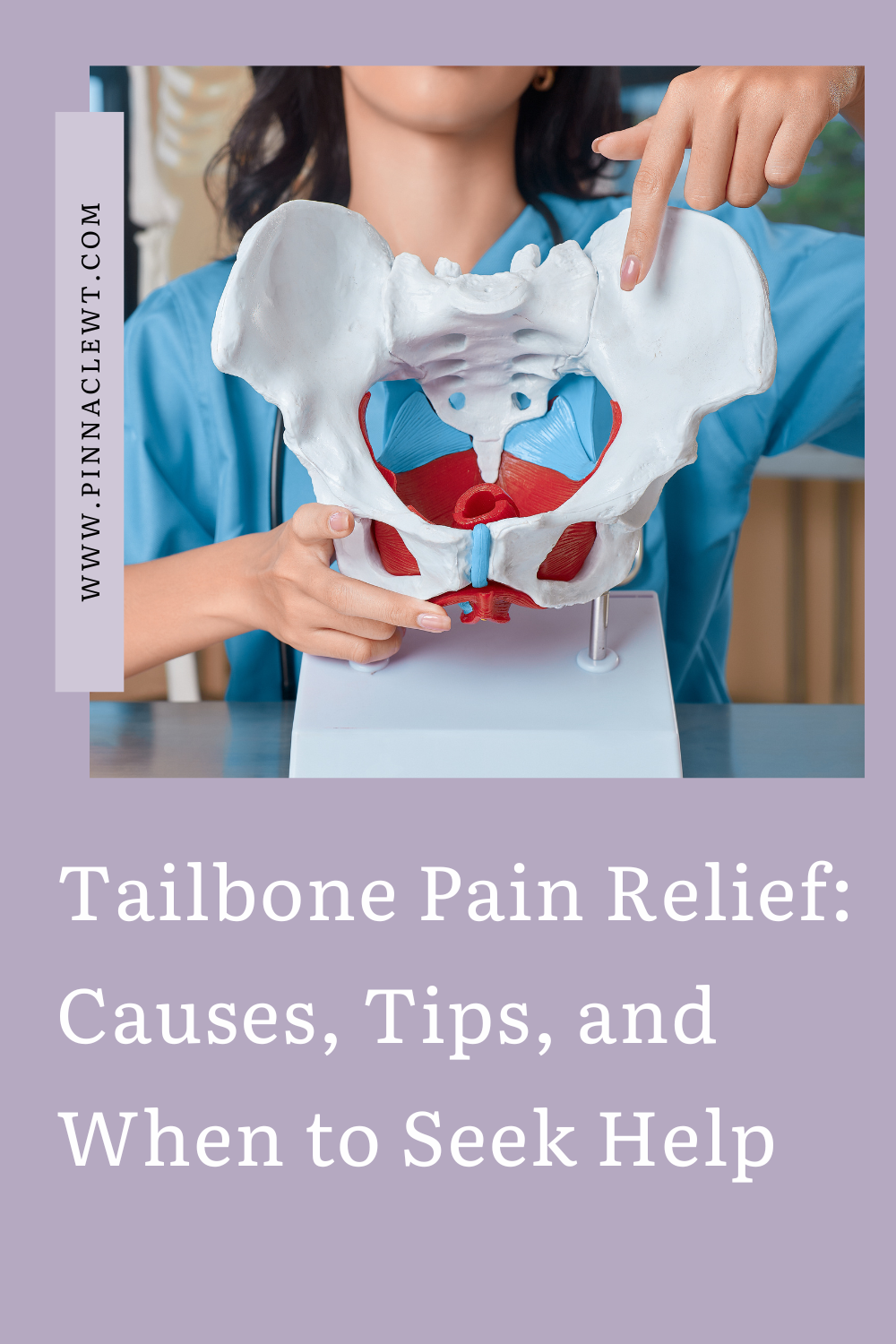Tailbone pain, also known as coccyx pain, can be incredibly uncomfortable and disruptive to daily life. Many people experience sharp discomfort while sitting, transitioning between positions, or engaging in activities that put pressure on the base of the spine. Despite how common this issue is, it is often misunderstood, with many patients being told there is nothing that can be done. This post will explore the causes of tailbone pain, practical tips for relief, and why pelvic physical therapy is uniquely positioned to help you recover.
What Is Tailbone Pain?
Tailbone pain is discomfort or aching localized at the base of the spine, just above the buttocks.
Symptoms can range from mild soreness to sharp, debilitating pain. Common indicators of tailbone pain include:
- Discomfort or sharp pain while sitting, especially on hard surfaces.
- Difficulty transitioning from sitting to standing or lying down.
- Pain that worsens with prolonged sitting or driving.
- Tenderness or swelling near the base of the spine.
Common Causes of Tailbone Pain
1. Falls and Injuries: A slip on icy steps, a tumble on a ski slope, or a fall down the stairs can result in tailbone pain. These impacts can bruise, dislocate, or even fracture the coccyx.
2. Childbirth Trauma: During labor, the coccyx can be pushed out of alignment or strained, leading to lingering postpartum tailbone pain.
3. Repetitive Strain: Prolonged sitting, especially with poor posture, can place continuous pressure on the tailbone, causing inflammation or pain over time.
4. Unknown Causes: Some cases of chronic tailbone pain develop without a clear incident but may be related to tension in the pelvic floor or surrounding muscles.
Why Tailbone Pain Persists
Pain in the tailbone often doesn’t resolve on its own because the surrounding muscles and tissues play a critical role in movement and posture. The pelvic floor muscles, which attach directly to the tailbone, can tighten or spasm after injury, childbirth, or prolonged sitting. Without proper treatment to address both the tailbone and these interconnected muscles, discomfort can become chronic.
How Posture Affects Tailbone Pain
Posture plays a significant role in both the development and persistence of tailbone pain. Sitting tilted onto the tailbone with the abdominals collapsed in front adds pressure on the tailbone and increases tension in the pelvic floor muscles that attach to it. Sitting with a tall torso positioned on the sit bones is ideal. This can be achieved by:
- Using a lumbar cushion: Place it at the apex of the lumbar curve in a chair to support better posture.
- Sitting on an exercise ball or wobble disc: These encourage the core muscles to engage naturally, helping to maintain a taller posture. However, they should be avoided if they increase tailbone pain.
- Modifying couch sitting: Large, soft couches often encourage a tilted posture onto the tailbone. Placing a very firm, thick cushion behind your back can help keep the body upright and reduce strain on the tailbone.
How Pelvic Physical Therapy Can Help
Pelvic physical therapy offers a unique approach to tailbone pain by addressing both the structural and muscular components of the issue. Unlike other healthcare providers, pelvic physical therapists have specialized training to evaluate and treat the pelvic floor—a crucial element in tailbone recovery.
What Makes Pelvic PT Unique?
- Specialized education on the connection between the tailbone, pelvic floor, and surrounding muscles.
- The ability to perform internal pelvic floor assessments and treatments, which are essential for releasing tension or spasms in these muscles.
Techniques Used by Pelvic PTs:
- Myofascial Release: Gentle manual therapy to release tension in the hips, glutes, and low back.
- Cupping Therapy: To reduce tension and improve blood flow in the sacrum, glutes, and surrounding areas.
- Gentle Stretching and Mobility Exercises: To improve movement patterns and reduce stiffness.
- Breathwork and Brain-Muscle Reeducation: Techniques to retrain the pelvic floor to relax and lengthen with proper breathing.
- Internal Pelvic Floor Therapy: Extremely gentle, targeted techniques to release tension in the pelvic floor without creating new pain.
When to See a Pelvic Physical Therapist
You should consider seeing a pelvic PT if:
- Your tailbone pain doesn’t resolve within a week.
- You have difficulty sitting comfortably or transitioning between positions.
- Pain interferes with your ability to work, drive, or perform daily activities.
- You’ve had a recent fall or injury that led to tailbone pain.
- You’ve experienced childbirth-related tailbone discomfort
Exercises and Tips for Tailbone Pain Relief
While seeking professional help is often the best course of action, there are simple exercises and techniques you can try to alleviate tailbone pain at home:
Gentle Exercises
1. Forearms and Knees Position:
-
- Get onto your forearms and knees, allowing the belly to relax and the tailbone to untuck.
- Focus on slow, deep belly breaths to encourage pelvic floor lengthening.
2. Cat-Cow Stretch:
-
- Inhale: Drop the belly, untuck the tailbone, and lift your head.
- Exhale: Arch your back, tuck the tailbone, and drop your head.
- Repeat 5–10 times at a slow, gentle pace.
3. Child’s Pose:
-
- Sit back onto your heels with your arms extended forward, allowing the tailbone to lengthen and relax.
Supplementary Care
- Warm Baths: Use Epsom salts or magnesium in a warm bath to relax tight muscles.
- Tailbone Relief Cushions: A donut cushion or specially designed pillow can reduce pressure while sitting.
- Movement Breaks: Avoid prolonged sitting by standing and stretching every 30–60 minutes.
Patient Success Story
One of our patients, a woman in her late 30s, came to Pinnacle Women’s Therapeutics after slipping on wooden stairs. Her tailbone pain was so severe that sitting was unbearable, and even lying down on the treatment table was challenging. Through a combination of gentle manual therapy, mobility exercises, and internal pelvic floor treatment, we addressed the root cause of her discomfort. Within four weeks, she experienced complete relief and regained her ability to sit and move comfortably.
Frequently Asked Questions (FAQs)
1. Can I exercise with tailbone pain?
Yes, as long as it does not increase pain at the tailbone. Exercises may need to
be adjusted to avoid creating more pressure on the tailbone.
2. Will my tailbone pain resolve without treatment?
It might resolve on its own, but it could take much longer without targeted interventions.
3. Is internal pelvic floor therapy necessary?
A pelvic physical therapist will assess your individual needs. Internal pelvic floor therapy is not always necessary, but it can be crucial for resolving muscle tension and spasms when indicated. The wishes of the patient are always respected, and internal treatment can be avoided if desired. Patient comfort and preferences are prioritized in every care plan.
4. What other issues can be caused by a tailbone injury?
Tailbone injuries can lead to constipation or pain with bowel movements due to the sphincter muscle’s attachment to the tailbone. A pelvic floor therapist can provide guidance and tips to address these issues.
Tailbone Pain: Don’t Suffer in Silence
If tailbone pain is interfering with your life, you don’t have to endure it alone. At Pinnacle Women’s Therapeutics, we specialize in treating the root causes of tailbone pain with a comprehensive, gentle approach. With the right care, you can find lasting relief and get back to doing what you love.
Ready to take the next step? Contact us today to schedule your consultation and start yourjourney toward healing.




